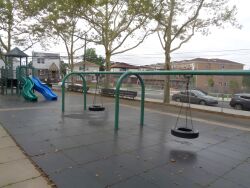Centreville Playground
Centerville Playground
Centerville Playground is bounded by 96th Street, Albert Road and its namesake, Centerville Street. The street itself was named for the horseracing track that stood at the intersection of Woodhaven and Rockaway Boulevards between 1825 and 1899. The area was the mecca of 19th century horseracing in New York City, during what is known as the “Golden Age” of racing. In the 1820s, the neighborhood now known as Ozone Park was famous for its two prominent horseracing facilities, the Centerville Racetrack and the Union Course racetrack. At one race, when the Union Course featured the best horses from the North and the South, 50,000 people came to the largely undeveloped area and wagered a total of about $200,000—an enormous sum for the time. Because of its isolation from lodging and entertainment venues, the popularity of the Centerville track suffered. Originally known as the Eclipse Course, the track’s name was changed to Centerville during an economic low point in order to promote the course as the center of town activity. Unfortunately, the name change failed to attract crowds, and in 1899 the track was divided into building lots. The legacy of Centerville lives on, however, in the playground named in its honor.
During the last decades of the Centerville Racetrack’s existence, a community gradually sprouted in the area. Music publisher Benjamin W. Hitchcock developed Ozone Park in the 1880s and marketed the area for its “invigorating and healthful breezes” sweeping in from Jamaica Bay and the Atlantic Ocean. Although today we associate “ozone” with environmental troubles, at the time the area was named the word connoted pleasant breezes and peaceful pastoral scenes—images attractive to dwellers of the bustling city.
In 1907, real estate developer David Leahy began to build small homes in the fields south of Ozone Park. He lured middle-class buyers with the promise that only a small down payment and additional monthly fees would secure them a “four-room cottage in the country.” Elevated train service to Jamaica began in 1908, making the area even more attractive to families wanting an escape from the busy city. Rockaway Boulevard, the area’s main commercial strip, was completed in 1922, and by 1957, the bordering neighborhoods of Ozone Park, South Ozone Park and Richmond Hill South together boasted a population of more than 130,000 residents. The horseracing tradition in Ozone Park continues today at Aqueduct Racetrack, located at Rockaway Boulevard and Southern Parkway.
When this site was acquired by Parks in 1957, the playground was named Ozone Park Civic Playground by local law. In May 2000, Parks began a playground rehabilitation focused on the actively used areas of the park. The toddler section received colorful and durable play equipment and new safety surfacing. In addition, the playground’s spray shower and baseball field were renovated. The park also has metal and timber-form play modules, and handball and basketball courts. Centerville Playground serves as a place of recreation today, while keeping alive the history of recreation in the area from more than a century ago.
Check out your park's Vital Signs
Clean & Safe
Green & Resilient
Empowered & Engaged Users
Share your feedback or learn more about how this park is part of a
Vital Park System








